|
|
by John Unrein “Did we win the day?” This question is often posed to the Eagles Football Team by Head Coach David Allie following scrimmages or offseason preparation work. It’s an important one as the message conveyed is centered around doing what’s needed to get better on a consistent basis. This was the first thing asked of the team as they assembled following their scrimmage at Lee’s Summit North on Tuesday, June 25th. Involved in the scrimmage were Grain Valley, Lee’s Summit North, and Pleasant Hill. All participants go through round robin play in helmets and shoulder pads only. Segments of the competition include rotating defenses versus offenses for a series of downs, driving the football with the opportunity for continuation upon getting a first down, and having time for younger players to face off against competition their own age. Efforts are made to keep physicality in check with quick whistles and only allowing a wrap, touch, or thud without tackling to the ground. “We try to be creative within the twenty days we are given by the State for offseason work. We were fortunate in the timing of when we got of school in that we could have our team camp prior to heading to Pitt State for a three-day college camp. On the field activities during Tuesdays in June as well as this scrimmage give us middle of the summer preparation prior to the dead week (no activities) in Missouri during the first week of July,” Allie said. “We’ve had great attendance this year. These kids have bought in and are showing up. Something like today they can look forward to and provides a reward for the hard work they put in. Winning the day is not necessarily about how many touchdowns we score or prevent in this setting. Instead, it’s about you coming out and performing to the best of your ability.” Among the active players on the field drawing praise from the Eagles coaching staff was Senior Linebacker Seth Dankenbring. He along with other members of the black shirt defense improved in consistency throughout the scrimmage with their run fits and angles of pursuit. “The best thing about today is that we got to compete together as a team in our preparation for the upcoming season. We accepted the challenge and played well against a bigger school like Lee’s Summit North as well as acknowledging our mistakes and being willing to get better because of them. We came in with an open mind set and got after it today. I am pleased with how we did,” Dankenbring said. Grain Valley Football will continue their preparation for the upcoming season with weight training picking up again on July 8th and varsity camp the week of July 22nd. The Eagles defense successfully pursues and corrals a Lee’s Summit North ball carrier. Photo credit: Valley News staff The Eagles ball carrier successfully eludes a Pleasant Hill defender. Photo credit: Valley News staff The offensive line goes through run step progressions. Photo credit: Valley News staff
by Marcia Napier, Grain Valley Historical Society Essie Matthews came to the Grain Valley Elementary School as a third and fourth grade teacher in the fall of 1951. Mrs. Matthews, along with her husband Calvin and daughter Carol, had moved to Calvin’s hometown of Odessa after spending a few years in Colorado. Those years in Colorado may have been responsible for her lifelong love of horseback riding. Mrs. Matthews spent a year in the elementary school before moving to seventh grade, a position she kept for seven years. I was fortunate to be in her class during the 1958-59 school year. In the fall of 1959, she became the elementary school principal. In those days being a principal or a superintendent was not considered a “full-time” position. Mrs. Matthews continued to teach one class of Freshman civics through the 1963-64 school year. In 1960, a six-room annex was added to the elementary school, doubling the size of the school. The elementary population continue to grow, and new programs were added in Special Education, Art and Music. When school opened in the fall of 1964, she became the first full-time principal at Grain Valley. (The senior high principal continued teaching American History for two additional years.) In 1974 the R-5 district purchased nine acres north of I-70 on McQuerry Road, and in 1977 patrons approved a $487,000 bond issue for Phase I of a new elementary school. On April 4, 1978, before construction was completed, an additional $75,000 bond issue was passed. The building was completed in time for classes in the fall. The building dedication took place on December 10, 1978 and was appropriately named Matthews Elementary School. Mrs. Essie Matthews continued to serve as the elementary principal until her retirement in 1980. The Grain Valley Historical Society Museum is located at 510 Main Street. Visit the Historical Society’s website, www.grainvalleyhistory.com, and follow the Society on Facebook, Twitter, and Instagram (@grainvalleyhistory). Matthews Elementary was dedicated on December 10, 1978 and was named for Mrs. Essie Matthews. Photo credit: Grain Valley Historical Society Former students came together to celebrate the Matthews’ 50th Wedding Anniversary: Back Row: Judy Miller Wilke, Celia Smith Jeffers, Karen Beck Barnett, Larry Graham, and Maurice Gibler. Front Row: Calvin and Essie Matthews.
Photo courtesy Grain Valley Historical Society
Sierra Tyson (left) interviews Madison Geiger (right) in preparation for Thursday’s Valley News edition. Grain Valley Schools Summer SOAR program’s journalism classes worked with Valley News staff on this edition, writing community profiles, creating editorial cartoons, and developing a story about their class.
Photo credit: Valley News staff
Fourth and fifth grade students attending the Summer SOAR program at Stony Point Elementary and Prairie Branch Elementary have spent the past month mastering their interviewing and writing skills. The Junior Journalists classes worked on researching, reporting, and producing daily and weekly stories on events happening during summer school.
Valley News visited with both classes during a session at Prairie Branch Elementary on June 26th, and students worked together on contributions for this article, editorial cartoons, and community profiles in this week’s edition. Summer SOAR instructors Kaitlyn Pavlica, a fourth grade teacher at Stony Point Elementary, and Theresa Huff, 6th grade English Language Arts teacher, North Middle School, worked with students to learn how to interview, research, write, and publish articles for publication. Students also took photographs, designed and published their publications using Google applications such as Google Docs, Google Slides, and Google Sites. “We also took our notebooks and interviewed people from different classes. We took pictures and did all of the writing,” Hayden Lucas said. Beyond school news, students researched and wrote on a variety of topics. “We researched and put together a folder on the Great Barrier Reef,” Jameson Dillinger said. During the June 26th work session with Valley News, students talked about the importance of the press, how to properly interview and document facts, and how to separate news from editorial or opinion writing. Students expressed how challenging it can be to come up with good questions and to conduct interviews. “The most challenging part of being a journalist is interviewing someone we don’t know. That was hard. We got better by the end of the class, though,” Brett Bieri said. Students interviewed each other as a part of their session with Valley News. Below are selections from interviews conducted by Junior Journalist students.
Editorial cartoons created by Junior Journalist students.
Summer nights often include a barbecue grill or gathering around the backyard fire pit. While these activities are some of the moved loved parts of summer, residents are asked to be mindful of the fire risks involved.
Deputy Chief Eddie Saffell, Deputy Chief, Administration, with the Central Jackson County Fire Protection District (CJCFPD), explains that the extensive rains the area has experienced in the past few months have eliminated many of the issues they see, but conditions will change quickly as summer arrives. “Once the rain stops and we truly get into summer, people don’t really understand how quickly things will dry out,” Saffell said. “As far as fire pits, chimineas, charcoal grills, etc., we ask people to be careful when using them. Watch for sparks and embers and make sure the fire is out before leaving the appliance unattended.” The US Fire Administration (USFA) recommends grills and outdoor fire pits be located no less than three feet away from homes and other structures, and that an adult monitors the fire or grill at all times. Ashes from grills and outdoor appliances are another common fire hazard. “One thing we see is people that will put the ashes from charcoal grills and other outdoor appliances into plastic or paper containers. Even though the ashes seem cool, it only takes a small ember and a little wind to flare back up. Once everything starts drying out, this becomes a concern,” Saffel said. Cigarettes are also a common culprit of outdoor fires. “The second most common call type for us is usually related to cigarettes. People need to be aware of smoking outside, especially on decks and with leaves and dry grass around. As with outdoor appliances, it only takes a small ember to cause a fire. People have a tendency to put their cigarettes out in a flower pot or planter with dry mulch or through it into the yard with dry leaves,” Saffell said. Burn bans are common in late summer, and CJCFPD monitors local weather conditions to determine if a ban is necessary. “Once everything starts to dry out, we will begin watching the weather. If the day is hot and dry with any wind, we will show a “no burning day” on a banner across the top of our web site and www.cjcfpd.org. What that means is any burning permits we have issued for burning brush in the county are suspended for the day, or longer,” Saffel said. “As far as areas within the city limits of Blue Springs, Grain Valley, and Lake Tapawingo, we have no authority to ask people to not burn in their outdoor appliances, but we highly encourage not using them and being even more aware of smoking materials.” Information regarding burn bans in the area will be posted on the CJCFPD website: https://cjcfpd.org/. The graphic at right, provided by the US Fire Administration/FEMA, outlines a number of tips for homeowners. Image credit: US Fire Administration  by Wayne Geiger My best friend, Jeff, and I, had put beach towels around our necks and used clothespins to securely hold them in place. Having just watched an episode of Superman, we were charged and ready. We were tired of watching the superhero and wanted to be the superhero.
I was somewhat naive at the young age of about seven, and mistakenly thought that the man of steel gained his ability to fly from his cape. I was wrong. With an energetic, “up, up, and away!”, I triumphantly leaped off the top of the bunk bed. Unfortunately, although unaware of its presence, a strong force, I would later learn to identify as gravity, grabbed a hold of me, pulling pulled me down to earth. I sank like a rock and landed ungracefully and hard upon his shag carpet. Thankfully, nothing was broken. Outside of a severe case of rug burn, the worst thing that hurt was my pride. I guess we’ve all dreamed of having a superpower. I think it was about 2002. At the time, I was the Station Manager for KLJC. A fellow radio employee and I were attending a radio conference in a major city and arrived at the hotel to check in. I really don’t remember what the issue was, but something was wrong with our reservation. We were both extremely tired as it had been a long day. He was extremely frustrated and his tone and body language only exacerbated the problem. I stepped in and apologized for the tense situation. I gave the clerk a quick smile and called her by name. I knew her name because it was written on her name tag. I used non-threatening language and described how frustrated she must be (I noticed the long lines in the hotel and the frazzled look on her face). I indicated that I was truly sorry that it had been a difficult day for her and we certainly did not want to add to her stress level. I also assured her that if anyone could resolve the issue, I knew it was her. Her attitude immediately changed. and within a few moments the issue was resolved and we were on our way. He looked at me, mouth agape, and said, “You must have some kind of superpower to get people to do what you want.” I smiled and said, “it’s just called “Being a nice human being.” I did not seek to manipulate. My goal was simply a win-win. We had an issue that needed to be resolved and we were in the right. She was the gatekeeper, but also a human being who deserved to be treated with dignity and respect. We met in the middle. I had no superpower, but I knew a few things about human behavior and simply tied my cape on. I believe that all of us were given an incredible superpower that has the ability to change the world. This superpower will not cost you a thing, is not affected by kryptonite, and wearing a cape is optional. The superpower I’m referring to is--a smile. Could it be that easy? Research into smiling has produced some amazing results. Studies have shown that smiling can help us cope, make us feel good, and even increase our longevity. In the Christmas movie, Elf, he has a big grin on his face and his boss asks him, “Why are you smiling like that?” Intensifying his smile and lifting his eyebrows, he says, “I just like to smile. Smiling’s my favorite.” To be honest, smiling is not really my favorite. It doesn’t come naturally. It takes work. I am introspective and love quiet moments. Most of the time in crowds, I prefer to listen or just think. I was in a meeting the other night and a friend asked, “Are you mad at something?” I knew what they meant. They were saying, “You look like Grumpy Cat.” My response was my normal one. “No, I’m fine. I’m just thinking.” Although a smile may not come naturally it can be extremely powerful. A smile is viewed around the world as a sign of friendliness--especially when giving a greeting. In fact, here is a common test. Which of these emoticons best displays a genuine happy smile? Is it :) or ^_^ ? Most say the second one. It is most commonly used in Japan. Researchers tell us the second one is the best description because smiling has less to do with your mouth and more to do with your eyes. The emoticon almost makes you want to smile. Here are 3 things you need to know about your new superpower: 1. Smiling can bring de-escalation: For some reason, we’re more drawn to people with a warm smile than people who don’t have one. When people are not smiling, we often want to know, “what’s wrong.” We assume that when things are right people are smiling. Smiling has also been shown to disarm a tense situation. When people smile, it sets us at ease and make us feel that we can trust that person. Similarly, when we smile, we have the power to be able to bring healing and calm into a tense situation. 2. Smiling is a stimulation The great Louis Armstrong sang, “When you smilin', when you smilin, the whole world smiles with you. Yes when you laughin' oh when you laughin', the sun comes shinin through.” Just as yawning is contagious, so is smiling. Not only does someone else smiling make us want to smile, but if we smile--it has the ability to change our own mood. Researchers say that once the smiling muscles in our face contract, there is a positive feedback loop that now goes back to the brain and reinforces our feeling of joy. Smiling triggers our brain to be happy. Just as happiness can cause us to smile, smiling can cause us to be happy. One author noted, “Smiling stimulates our brain’s reward mechanisms in a way that even chocolate, a well-regarded pleasure-inducer, cannot match.” The Bible says, “A cheerful heart is good medicine” (Prov. 17:22). 3. Smiling in an invitation A frown, growl, or scowl is a defense mechanism to warn others to, “Stay away, I haven’t had my coffee.” They are useful sometimes. On the other hand, a smile produces warmth and openness. It lets others know, ‘I’m approachable.” True, sometimes we fake it. The true smile is called the duchenne smile. It is named after the scientist who discovered that people can often tell the difference between a fake and a real smile. A fake smile is with the mouth only. A real smile also involves the eye sockets and produces “crows feet” under the eyes. But, oftentimes, a fake smile will grow into a genuine smile. For example, in a socially awkward moment, you might offer a “fake” smile to a stranger as a courtesy. Then, as you begin to converse, you realize you are enjoying the conversation and your smile becomes genuine. Smiling is easy. It’s powerful, and it’s free. If you’re not a natural smiler, try it for a couple of days. When you meet someone or in a social situation, remind yourself to smile. Unlike Superman, you may not be able to fly. However, a simple smile may be able to bring calm, joy, and an opportunity to meet a new friend. All of us, in some way, want to change the world. Maybe a great place to begin is with a smile. Who knows, it might just become your new favorite. Wayne Geiger is the Pastor of First Baptist Grain Valley, an Adjunct Associate Professor of Speech, and freelance writer. He can be reached at waynegeiger.com. 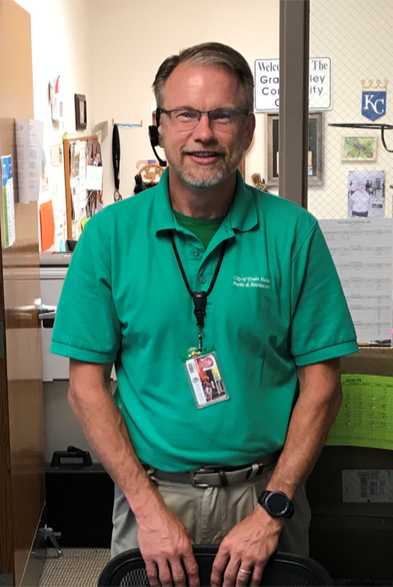 The Grain Valley Community Center offers a variety of programs and events for our city. Overseeing the building, reservations, and financing for programs is Jim Meyer. He’s served in his current role as Community Center Manager since 2002. Meyer’s previous career experience in the hospitality industry has served him well in the 17 years he has worked in his current position. “I get energy from people. I worked in the hotel industry for years prior to working in this position. I enjoy trying to take care of people and seeing them happy. Parks and Recreation has been a great fit for me in trying to provide a service that supports people,” Meyers said. Meyer’s success in his professional career has been built on relationships. Stop by the Community Center, and there’s a good chance you will witness him diligently finding answers for people, making sure everyone has what they need, and working to keep things organized in the building. It’s apparent that he genuinely enjoys being an ambassador for the City of Grain Valley. “Our goal is that once they (a community member) find us, we want to support them in finding the right class or program to best suit their needs. Building positive energy through learning in our community grows relationships.” “We have a marquee sign, a community calendar in our town newspaper, and word of mouth that all let the information spread about we do and can offer to further interactions and personal connections among people,” Meyers said. “Jim at the Gym”, as he jokingly refers to himself, is involved within the community outside of work as well. He’s currently the Vice-President of the Grain Valley Assistance Council, an affiliate of the Community Services League. Meyers is also actively involved in the First United Methodist Church of Blue Springs. Serving on the hospitality committee for part of the approximately twenty years he’s been a member with the church. Meyer chooses to work and live in Grain Valley after falling in love with the community. He and his wife moved here from outside of Lincoln, Nebraska after Meyer accepted a job in the hospitality industry. They have enjoyed raising their family here and the education their children received from the school district. Meyer encourages residents to make time to try new activities and stay active. “I encourage people to give it a try. In today’s world, people are close to making that choice that their busy lives keep them from. That tennis class, setting up a rental of a facility, etc. Don’t sell yourself short. It usually works out well,” Meyers said. Have a suggestion for a community profile? Send your suggestions to [email protected] Many taxpayers were surprised to learn they were getting a smaller refund than in prior years – or worse, that they owed money – when they filed their 2018 tax returns.
And while it may have seemed like they were getting back less money than they had in the past, most taxpayers actually paid less in taxes in 2018 than they did in 2017. That’s because the IRS updated the Federal withholding tax tables in January 2018 based upon tax cuts in the new tax law. The change effectively gave everyone their tax refunds early by withholding less from paychecks, which resulted in lower refunds at the end of the year. If you like getting a refund, you need to change your withholdings as soon as possible so you will have more paid in by the end of the year. Since it’s already June, however, remember you will only see half the impact of withholdings changes on your 2019 tax return. Keep in mind, too, that a refund means you have given the government an interest free-loan. That said, many taxpayers use their tax refund as a savings account, because they know they tend to spend the money they receive in their paychecks. There are other ways to save as well. Many employers offer other opportunities to transfer money to a savings account via payroll deduction, so you never see the money. And if you choose an interest-bearing savings account, your money will grow faster than if you “loan” it to the government on an interest-free basis. Be sure to consider all of your options for savings and adjust your withholdings accordingly. If you need to save more money, take action now one way or another. Change your Federal withholdings, or set up a payroll deduction to a savings or other account. Before you change your withholdings, consider consulting with a certified public accountant because every taxpayer’s situation is different. Here’s an example: If you receive paychecks biweekly (every two weeks) and asked your employer to deduct an additional $50 per paycheck, you would pay in an additional $1,300 over the course of a year. Put another way, you would increase your refund by the same amount: $1,300. But remember, you would only see half of that for your 2019 return, or approximately $650, since the year is half over. If you would like some help adjusting your payroll withholdings or learning how to maximize your earnings, please contact Lorne Meinershagen, CPA, at Floyd, Meinershagen & Co. (FMC): 816-847-0536 or [email protected]. This week, Valley News celebrates our first anniversary. Traditionally, a first anniversary gift is paper, as it symbolizes new beginnings and the fragility of a new relationship. Seems fitting that we celebrate our first year of serving our community with this print and online edition.
We are so grateful for the partnerships we’ve established, the talented writers who share their stories, the advertisers who make this publication possible, and the readers who are so encouraging and loyal. When we introduced ourselves in the first edition, we quoted the famous line from Forrest Gump: “Are you crazy, or just plain stupid?” Starting a newspaper in this ever changing media landscape is risky at best, but we firmly believe in the importance of community journalism and are honored to work for you. As Jeff Moriarty with Johnson Press so eloquently explained, “We continue to play an important role in our local communities. Even in the age of social media, people still want to feel connected, to know what is going on around them, for someone to hold power to account and be an advocate for the place they live. No matter the platform, that continues to be our role.” Thank you for your readership and support. We look forward to serving you for many more years to come. A casual observer might see the group recently gathered around a table at the Grain Valley Price Chopper cafeteria as just a typical group of friends meeting up for lunch. The laughter and teasing was plentiful, and phones were passed around to giggle about a funny meme. But, this group of friends is proudly atypical, and their connection comes from understanding what most people cannot see or understand. Connecting with those who understand is at the heart of much of the work for the Purple Peace Foundation. The Purple Peace Foundation, a 501c3 nonprofit organization, was started in March 2012 in memory of Amanda Brady, a Grain Valley resident who died at age 13 following complications from epilepsy. Amanda’s parents, Mark and Holly Brady, founded the organization in an effort to raise awareness about epilepsy and provide support to those living with epilepsy. Shannon Walter-Colledge and her children Cole and Cayla were able to travel to Disneyland last November for Epilepsy Awareness Day thanks to the support of the Purple Peace Foundation. For three days, the family was able to experience an expo of over 3,000 attendees to attend workshops, gather resources, and connect with others who also deal with epilepsy. The family also enjoyed two days at Disneyland as a part of the trip. Cole, a recent graduate of Raymore-Peculiar High School, was diagnosed with epilepsy at age 8. “When you have epilepsy, you feel secluded from life. People look at you differently. I feel different than everyone else, and I sometimes wonder, ‘What did I do to deserve this’,” Cole said. Cole was encouraged by the trip and is continually encouraged by the friends he has made participating with the Purple Peace Foundation. “They make me comfortable. I don’t have to explain myself or worry about people looking at me or not understanding my condition.” Cole’s sister Cayla found comfort in the Disneyland trip and in participating in Purple Peace Foundation activities. “It was an eye opener to go to Disneyland and see how many people there are that are affected by epilepsy. It makes you feel less alone, knowing that there are others who understand what you are going through,” Cayla said. “When your family has epilepsy, you often feel like there is no one else who understands.” Stacey Perry, a dedicated volunteer to the Foundation who also has epilepsy, was struck by Cayla’s statement that the “family has epilepsy”. “That is so profound,” Perry said. “I always say that I have the seizures, but my family has epilepsy. She nailed it when she said that,” Perry. Perry’s family has also attended the Epilepsy Awareness Day events at Disneyland and explains that it is so much more than just a fun day at an amusement park. “It’s seminars, and resources, and 3,000 people walking around in purple shirts who you know understand what you are going through. From my husband’s standpoint, there are other husbands there who are taking care of their wives. Husbands who understand what it means to be both a husband and a caregiver,” Perry said. “We struggled for years to find a group of people who we could relate to. This group has been a lifesaver for me. As a single mom, I tried to not put any responsibility or burden on Cayla. Finally, I have people who I can relate to and reach out to,” Walter-Colledge said. Taylar Spire, a recent graduate of Blue Springs South High School, was diagnosed with epilepsy last July. Spire had a seizure while driving and her car ended up in a ditch. She was diagnosed not long after the accident. Taylar’s father, Steve Spire, recalls the phone call after her accident. “That was a horrible call,” Spire said. Taylar can no longer drive due to her diagnosis, which puts a strain on her parents to coordinate travel to school and activities. “Taylar was in the color guard, and getting her to all of her practices and back and forth from school was a challenge. We’ve depended a lot on family and friends to help with that,” Spire said. “I’m used to being the one that helps fix everyone’s problems, but now I’m the one that has to ask for help. It can be tough,” Taylar said. The Spires connected with the Purple Peace Foundation after attending the organization’s car show fundraiser last August and attend activities to make connections with families in similar situations. Through informal get togethers and more formal “Connections” support groups, the Foundation aims to create opportunities for families like the Spires to connect with others in similar situations. “We’ve been able to provide monitors for people and help people access resources like Epilepsy Awareness Day, but getting these groups started has been one of the most beneficial things that our foundation has been able to do,” Holly Brady said. The organization raises funds in order to provide tools which may improve the quality of life for someone living with epilepsy, to support epilepsy research, and to increase awareness and education about epilepsy. The Foundation hosts a number of fundraising events annually to support programming, including the Cruise for Consciousness Car Show for Epilepsy Awareness on August 4th at the Grain Valley Community Center Pavilion and a bowling tournament scheduled for November 17th at Lunar Bowl. The Foundation will once again sponsor a family to go to Epilepsy Awareness Day at Disneyland this year. Applications will be available next week and will be due the first week of August. For more information on the Purple Peace Foundation, visit www.purplepeacefoundation.org. Families impacted by epilepsy gathered recently for lunch at the Grain Valley Price Chopper. The Purple Peace Foundation, a local nonprofit dedicated to raising funds to provide tools for those with epilepsy and supportive programs for families impacted by the condition, coordinates a number of formal and informal gatherings as a part of their work. Photo credit: Valley News staff Left to right: Steve Spire, Taylar Spire, and Holly Brady enjoy a light hearted moment over lunch with friends from the Purple Peace Foundation. Brady started the organization with her husband Mark after losing their daughter Amanda in 2011 due to complications from epilepsy.
Photo credit: Valley News staff by Cathy Allie  Back in the day (as my daughter likes to call any time past Tuesday) at the end of CBS’s 60 Minutes, commentator Andy Rooney used to take a few minutes and grouse about whatever had him sideways at the time. A classic Rooney was, "I don't know anything offhand that mystifies Americans more than the cotton they put in pill bottles. Why do they do it? Are you supposed to put the cotton back in once you've taken a pill out?" That rant still ranks as one of my all-time favorites. Another time he called modern street art work in Washington, D.C. ugly and invasive, saying “It makes about as much sense as the politicians there.” I suppose I think this one still applies. He picked on speech, pop culture, habits, pretty much everything and everybody except nuns. I used to watch him and think to myself what a crabby old man he was. But as I’ve aged and the world around me swirls, I find myself on occasion in an Andy Rooney state of mind. First, I hate the way people use their turn signal when they’re driving. According to the way I learned to drive, the signal is an indication that awaits an invitation. I flip on my signal to indicate I want to come over, and then I sort of wait for the invite, either by speeding up a little to merge in front of someone, or backing off the gas to allow me to fold in behind. But literally every. single. day. on my I-70 commute, a driver flips on the signal and in one half milli-second enters my lane. Numerous times I have had to slam on my brakes, swerve or begin praying, as I move to avoid the rampant signaler. The ripple effect with the driver behind me is usually less than pleasant. I am just trying to avoid a wreck, I say, sometimes out loud, creating the illusion that I am talking to myself and am verifiably crazy. Notice how I said wreck? This is another of my latest pet peeves. I listen to the traffic reporters each morning before my commute, and each day I hear them talk about all the crashes. But what I really think they mean is wrecks. Here is the dichotomy—two vehicles crash into each other and create a wreck. When they say, “We have lots of crashes on the roads today,” they sound like 7 year-olds describing their Hot Wheels car play. “See, Mom? I’m gonna’ crash all these cars into this truck,” little Paul screams. Pick the more grown up verb and call them wrecks. Maybe those folks that wrecked were on the way to the airport where TSA will screen their bags right in front of the waiting room window, so all the world gets a glimpse of their Chewbacca boxers or rumpled slip. Andy would really hate that! I am guessing he also would not like to share seats with a fellow passenger who believes BOTH arm rests are hers. On my last flight, I had folks on both sides who each claimed both arm rests, leaving me to tuck my arms deep into my sides like an Irish dancer. I was so stiff by the time we landed, I believe I had contracted arthritis on the flight. In fact, many of my Rooney’isms have to do with personal space and people crossing boundaries. Don’t touch the items I have just put on the conveyor belt at the store, examining them like museum artifacts. They are mine. Get your own. And while I am at it, don’t stand so close to me in line. No one is joining us in the 3 inches you have left for wiggle room, to cut in front of you in line. I should not be able to feel your warm breath on my neck. As a former English and journalism teacher, I am a little bit pre-disposed to be irritated with others’ grammar. Truly, when we meet for coffee, I am not silently judging you, but let me cover a few that are high on my list of Andy Rooney-like complaints. The first is irregardless vs. regardless. There was so much debate over whether irregardless was actually a word, that lexicographers around the world had to go to great lengths to explain it, then they made it an official dictionary entry just to share the explanation, which tells why it is not really a word. Turns out it is sort of a cross-pollination of two words, irrespective and regardless. It is just basically an emphatic use of regardless, and I am happy to say that even as I type this, my grammar autocorrection system wants it to say regardless instead. A second big time peeve of mine is the misuse of the phrase, “I couldn’t care less,” which should be used to mean that it is low priority, not bothering me, just a nothing. But people routinely say, “I could care less,” which literally interpreted means they actually do care, the opposite of what they are saying. If I am with my husband when I hear this, he will reach out and grab my hand and try to start conversation on another topic so that I won’t ask for the person’s list of things about which they could care less. Just this week, I heard it in passing. I was waiting to get a hair trim and to get my eyebrows touched up, because unlike Andy Rooney, I am concerned about the crazy toupee looking things above my eyes. “I just told my daughter I could care less about what she thinks about her curfew,” another customer said. So what ranks lower? Her fast-driving friends? Her dirty hair? Pierced tongue? I nearly bit through mine. I am also pretty adamant about first-come, first served, which has a d at the end, as well. Billboards, television commercials, print ads all leave off that precious d. So by saying first-come, first-serve, the speaker indicates that those who arrive first will be the ones who serve everyone else, probably not the idiom’s intent. Before this column goes completely grammar guru, let me just remind gentle readers that we just thaw meat, and not unthaw it; a mute point could never be made aloud because mute means silent, while a moot point is debatable or doubtful; and a strong coffee drink is espresso, pronounced with an "s" in the first syllable, and expresso is not a word, unless it joined its brother irregardless in the latest Webster release. Cathy is a retired public school English teacher and Public Information Officer. |
Categories
All
Archives
July 2024
|
Grain Valley NewsGrain Valley News is a free community news source published weekly online. |
Contact Us |


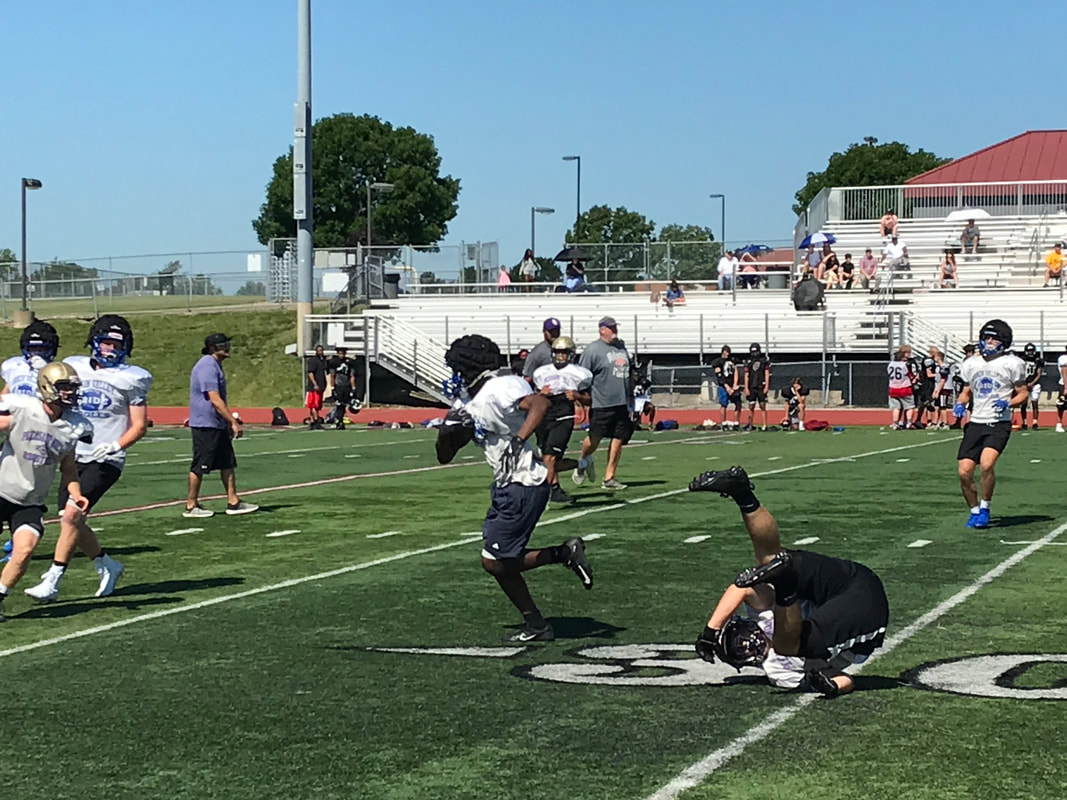
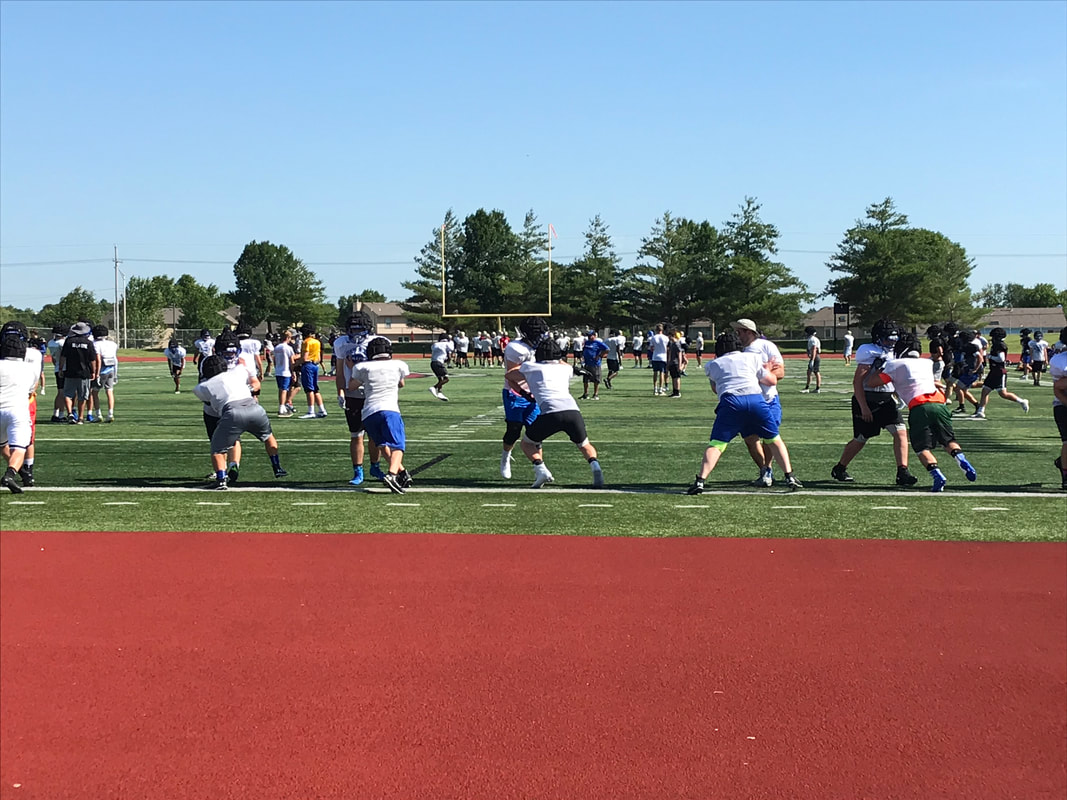
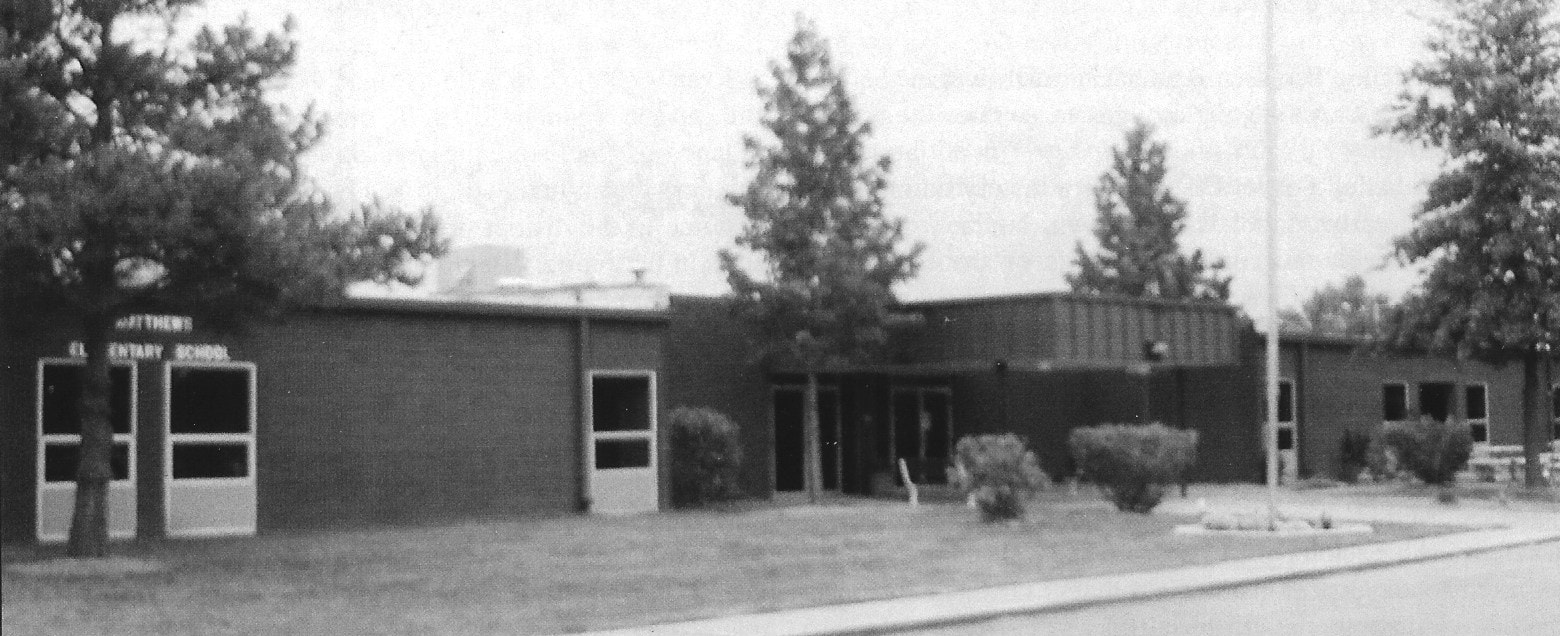
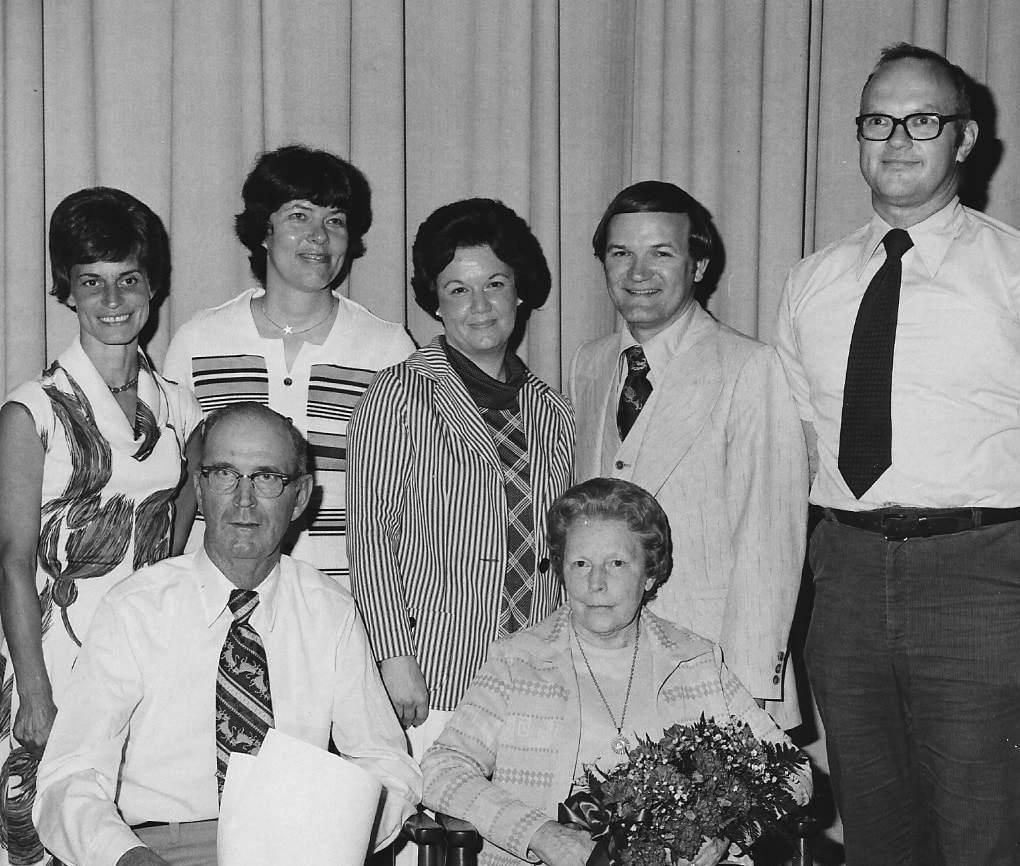

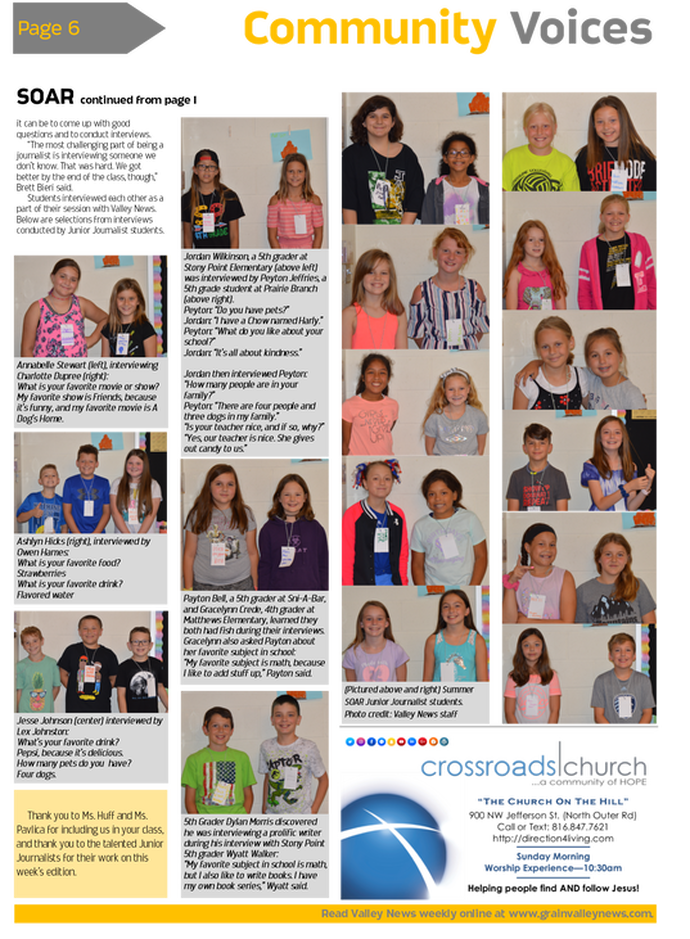


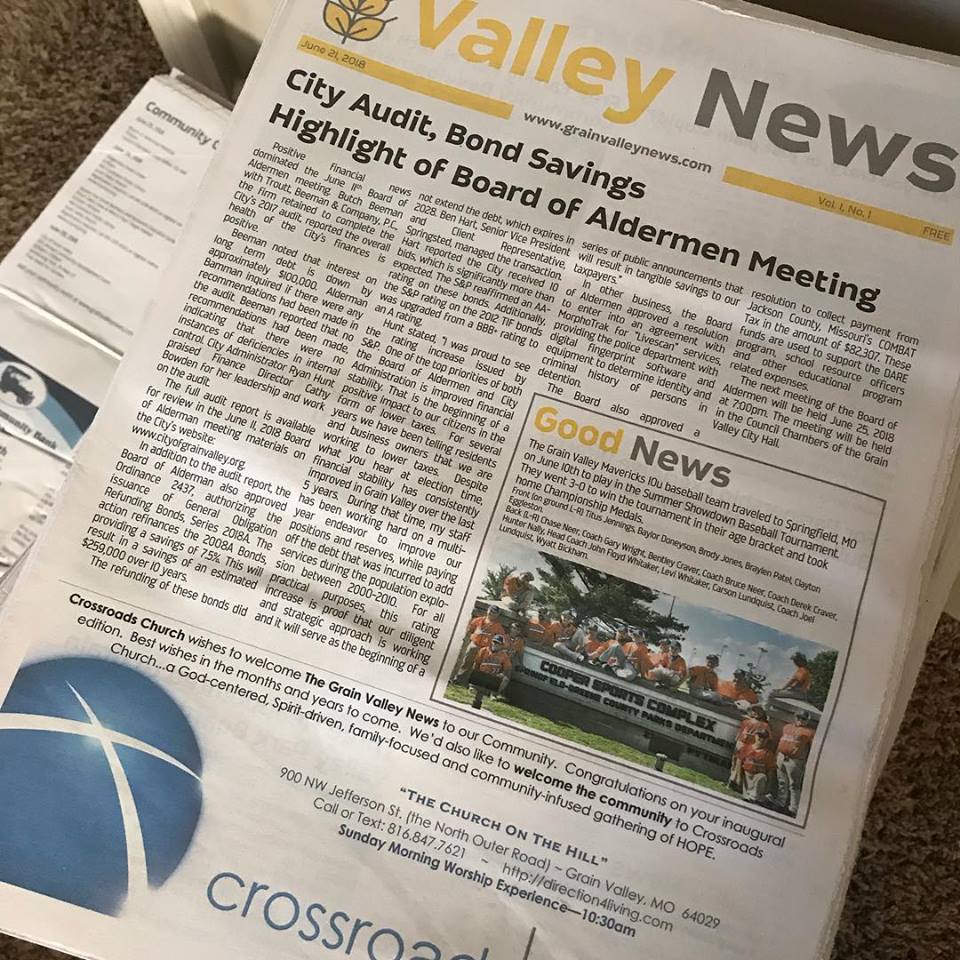
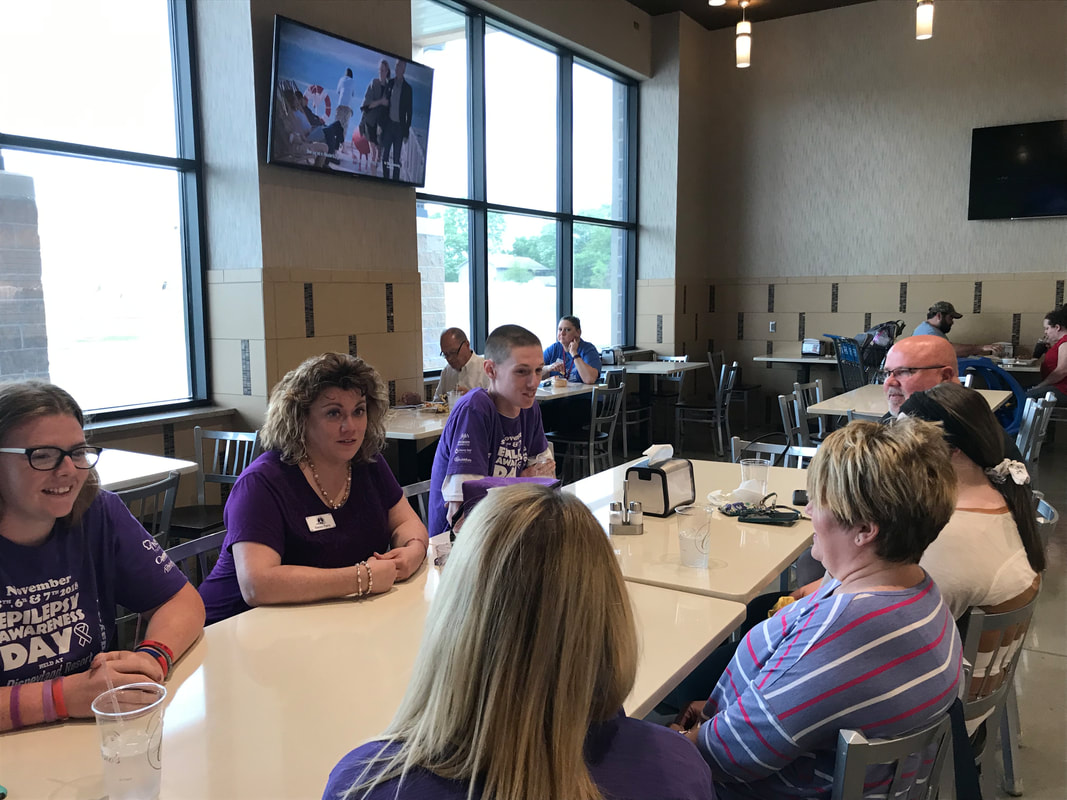
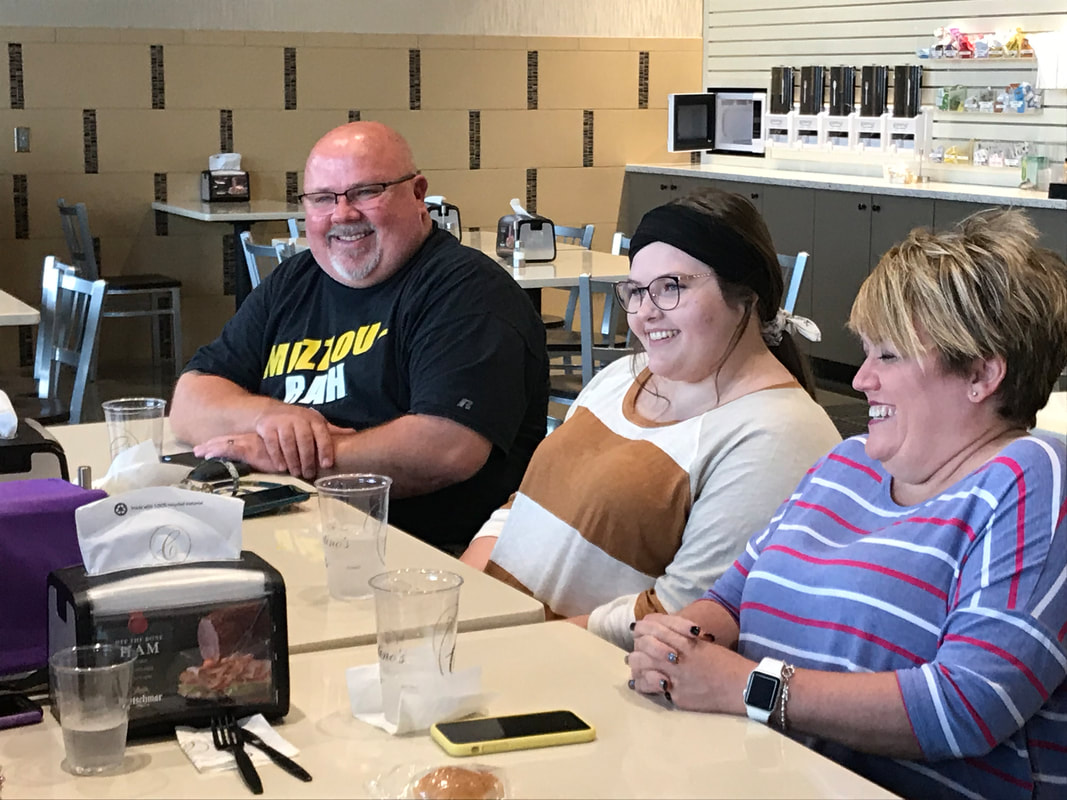
 RSS Feed
RSS Feed
